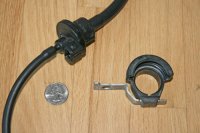Here is a solution I used with an earlier version of Megasquirt. There is a small one-way valve from the 1991 735i engine I am using for my 3.5l conversion. I connected one end to the lower vacuum port on the throttle body and the other end to a spare port on the manifold log. This valve is open by default (but in one direction only - the larger hose goes to the manifold). When powered on the valve will close. So, using a special relay (two pole - basically a reverse relay) you set it up as follows: When the engine is running the relay provides power to the valve (keeping it closed). When the AC comes on the relay cuts power to the valve, thereby allowing it to open and letting additional air into the manifold and, with Megasquirt, more fuel is added, hence slightly higher RPMS. It worked nicely. The valve size was about right for the amount of air it let through. I am assuming that when the D-Jet system senses more air in the manifold then more fuel is added?
The D-Jet may not have a spare port on the throttle body, in which case you could tap somewhere between the air cleaner and the TB.
Two-pole relay wiring: 12v to pin 30, Ground to pin 86, AC ON wire to pin 85, and one valve wire to pin 87a. The other valve wire goes to ground. You will need to tap into the wire going to the AC compressor for pin 85.
Valve PN# Bosch 0 280 142 150
Rubber holder PN# BMW 1 717 292 (this is the rubber part, it may not include the metal bar)
I will not using this valve, as the newer megasquirt 3/3X has AC control built-in to control the main idle air valve. But I plan to hang on to the parts until I can test this new setup.

